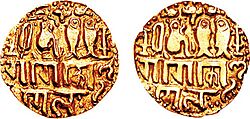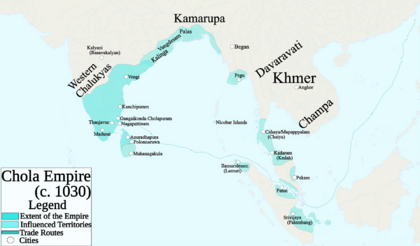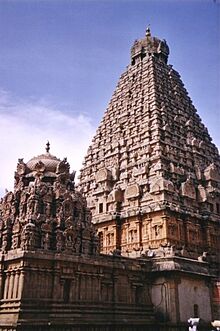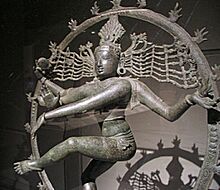Chola dynasty facts for kids
Quick facts for kids Chola Dynasty |
|
|---|---|
| Imperial, and Royal, dynasty | |

Imperial coin of Emperor Rajaraja I (985–1014). This coin shows a tiger and two fish.
|
|
| Country |
List
Chola Empire
Chola Kingdom Anuradhapura Kingdom Kakatiya dynasty Chodaganga Dynasty Kadaram Kingdom of Velanati Kingdom of Nellore Kingdom of Pottapi Kingdom of Nannuru Kingdom of Konidena Kingdom of Niduga Raja of Cebu Rajahanate of Sanmalan Other smaller historical states |
| Etymology | Chola Nadu |
| Founder | Ilamchetchenni (first documented) |
| Final ruler | Rajendra III (main branch) |
| Titles |
List
|
| Deposition | 1279 |
| Cadet branches |
|
The Chola dynasty was a powerful Tamil family from southern India. At its strongest, it ruled the Chola Empire, a huge empire that controlled the seas. The first mentions of the Cholas are from the 3rd century BCE. This was during the time of Ashoka and the Maurya empire.
The Chola empire became very powerful in the mid-9th century CE. They were one of the Three Crowned Kings of Tamilakam, along with the Chera and Pandya families. The Chola dynasty ruled different areas until the 13th century CE.
The main area of the Cholas was the rich valley of the Kaveri River. They ruled a much larger area from the late 9th century to the early 13th century. They united southern India below the Tungabhadra River. They kept this area as one state for three centuries. This was between 907 and 1215 CE.
Under kings like Rajaraja I and Rajendra I, the empire grew. It became a strong military, economic, and cultural power. This was true for both South Asia and Southeast Asia.
Contents
Understanding the Chola Dynasty
Where Did the Cholas Come From?
There is not much written information about the Cholas before the 7th century CE. We learn about the early Cholas from old Tamil writings. These are from the Sangam period (around 600 BCE). We also learn from old stories, religious texts, and temple writings.
Later Chola kings also said they had a very old family history. The Cholas are mentioned in Ashoka's writings. These writings are from 273–232 BCE. They say the Cholas were friendly neighbors to Ashoka's empire in the South.
Old books like the Periplus of the Erythraean Sea also talk about the Chola land. They mention its towns, ports, and trade. The Mahavamsa, a Buddhist book from the 5th century CE, tells of fights. It describes conflicts between people in Sri Lanka and the Cholas in the 1st century BCE.
The name Chola is likely the name of an ancient ruling family. Other names for the Cholas were Choda, Killi, Valavan, Sembiyan, and Cenni. Killi might mean a worker of the land. Valavan probably means ruler of a fertile country. Sembiyan means a descendant of Shibi. Shibi was a legendary hero who saved a dove.
Chola History: A Timeline
The history of the Cholas has four main parts.
- The Early Cholas from the Sangam literature.
- A time when the Cholas were less powerful.
- The rise of the Imperial Cholas under Vijayalaya (around 848 CE).
- Finally, the Later Chola dynasty, starting with Kulothunga Chola I in the late 11th century.
Who Were the Early Chola Kings?
The first Chola kings we have clear evidence for are in the Sangam literature. Scholars believe these writings are from the last centuries BCE and early centuries CE. We don't know the exact order of these kings.
These old writings also tell stories about mythical Chola kings. One story is about King Kantaman. He was said to be a friend of the wise man Agastya. His devotion brought the Kaveri River into being.
Two important Chola kings from Sangam literature are Karikala and Kocengannan. Their oldest capital was Urayur (now part of Thiruchirapalli). Kaveripattinam was also an early Chola capital. The Mahavamsa says that a Chola prince named Ellalan took over the Rajarata kingdom in Sri Lanka in 235 BCE.
A Time of Change for the Cholas
There is not much information about the period from 300 CE to the 6th century. During this time, the Pandyas and Pallavas became powerful. An unknown group called the Kalabhras invaded Tamil country. They took over the existing kingdoms.
The Cholas almost disappeared from Tamil land during this time. However, a branch of their family, the Telugu-Cholas, can be found in another region. They ruled as local leaders for the Pallavas. Many Telugu Chola families claimed to be related to the ancient Tamil king Karikala Chola.
The Cholas had to wait three centuries to become independent again. This happened when Vijayalaya Chola took power in the 9th century. He overthrew the Pallavas and Pandyas. Before this, the Mutharaiyars ruled the Thanjavur kingdom. Vijayalaya Chola captured Thanjavur from them between 848 and 851 CE.
Even when the Cholas were less powerful, other kingdoms respected them. The Pandyas and Pallavas sometimes married Chola princesses. This shows their high regard for the Chola family.
The Powerful Imperial Cholas
The Chola Empire was started in 848 CE by Vijayalaya. He was a descendant of the Early Cholas.
The early Chola kings made their territory and power bigger. In the early 10th century, the second Chola King, Aditya I, defeated the Pallava and Pandyan dynasties. He captured important regions like Tondaimandalam. Later, Aditya's son Parantaka I defeated the Rashtrakuta dynasty and the Pandyas.
Rajaraja I and Rajendra I made the dynasty an empire in the 11th century. They created a powerful empire around the Bay of Bengal. The famous Brihadeeswarar Temple was also built during this time. The Chola dynasty was at its strongest in the 11th century.
Rajendra I conquered Odisha and the Pala dynasty of Bengal. He reached the Ganges river in northern India. Rajendra Chola I built a new capital called Gangaikonda Cholapuram to celebrate his victories. Rajendra Chola I also successfully invaded the Srivijaya kingdom in Southeast Asia. This led to the decline of that empire. He also finished conquering a kingdom in Rajarata in Sri Lanka. He sent three groups of diplomats to China.



The Western Chalukya empire often tried to break free from Chola rule. This was mainly because of Chola influence in the Vengi kingdom. The Western Chalukyas tried many times to fight the Chola emperors. But the Cholas usually won and collected taxes from them.
The Cholas helped bring about the end of the Chalukyas. They supported the Hoysalas and defeated the Western Chalukyas in wars between 1185 and 1190. The Chola empire remained strong until 1215. Then, the Pandyan empire took over, and the Cholas ended by 1279.
From 1150 to 1280 CE, the Pandya dynasty became the Cholas' biggest rivals. They constantly fought to gain independence. The Cholas also fought with the Eastern Gangas. The Cholas controlled the eastern coast through their local rulers. These rulers helped the Cholas in their wars.
The Cholas also fought with the Sinhala kings of Sri Lanka. These kings tried to remove Chola control from Rajarata. But the Cholas kept firm control until King Kulottunga I. Later, King Rajadhiraja Chola II defeated the Sinhalese and their allies. This kept Rajarata under Chola rule. His successor, Kulottunga Chola III, made Chola control even stronger. He stopped rebellions in Sri Lanka and Madurai. He also defeated Hoysala generals. Kulottunga Chola III later made a marriage alliance with the Hoysalas.
Chola Overseas Adventures
During the reigns of Rajaraja Chola I and his successors, the Chola armies invaded many places. These included Sri Lanka, the Maldives, and parts of Southeast Asia. Rajaraja Chola I led naval attacks that captured Sri Lanka, the Maldives, and the Malabar Coast.
In 1025, Rajendra Chola attacked the ports of Srivijaya and the Burmese kingdom of Pegu. A Chola inscription says he captured or looted 14 places. These include Palembang and Kedah. A second invasion was led by Virarajendra Chola. He conquered Kedah in Malaysia in the late 11th century.
The Chola invasions did not lead to direct rule over Srivijaya. They were short and aimed at getting wealth. However, these invasions greatly weakened Srivijaya's power. This allowed new local kingdoms to form. Tamil traders also became more active in areas once controlled by Malay traders.
The Later Cholas (1070–1279)
Chola kings often married into the Eastern Chalukyas royal family. Rajaraja Chola's daughter married a Chalukya prince. Rajendra Chola's daughter, Ammanga Devi, married another Chalukya prince.
In 1070, Virarajendra Chola's son, Athirajendra Chola, was killed. Kulothunga Chola I, the son of Ammanga Devi, became the Chola king. This started the Later Chola dynasty.
The Later Chola dynasty had strong rulers. These included Kulothunga Chola I, Vikrama Chola, and Kulothunga Chola III. They conquered Kalinga, Ilam, and Kataha. However, the later Chola rule from 1218 to 1279 was not as strong.
Around 1118, they lost control of Vengi and Gangavadi. But this was only for a short time. King Vikrama Chola quickly won back Vengi and Gangavadi. The Chola empire was still mostly intact under Rajaraja Chola II (1146–1175). This is shown by the building of the Airavatesvara Temple at Dharasuram.
Chola rule was stable and rich until 1215. But then, the Chola power began to decline. They lost control of Sri Lanka. The Sinhala power there grew stronger.
The Pandyan dynasty also became very powerful in South India. This led to a civil war among different claimants to the Pandyan throne. The Cholas and Sinhalas got involved in this war.
Why Did the Chola Empire Decline?
The Chola empire became smaller in the final years of Kulothunga I. His successors, Vikrama Chola (1118–1135 CE) and Kulothunga Chola II (1133–1150 CE), were good leaders. They avoided unnecessary wars.
Kings like Rajaraja II (1146–1173 CE) and Kulothunga Chola III (1178–1218 CE) were active in politics. They saw the rise of the Pandyas. During this time, there were also more disputes and tricks about who would be the next Chola king.
The Cholas helped end the Chalukya empire by supporting the Hoysalas. They defeated the Western Chalukyas in wars between 1185 and 1190. The Cholas remained stable until 1215. But then, the Pandyan empire took over. The Chola empire ended by 1279.
Kulottunga Chola III made Chola control stronger by stopping rebellions in Sri Lanka and Madurai. He also defeated Hoysala generals. He later formed a marriage alliance with the Hoysalas. This improved their relationship.
Life and Culture in the Chola Empire
Where Was the Chola Territory?
The Chola country included parts of modern-day Tamil Nadu. These areas are Tiruchirapalli District, Tiruvarur District, Nagapattinam District, Ariyalur District, Perambalur district, Pudukkottai district, Thanjavur District, and Karaikal District.
The Kaveri River and its smaller rivers flow through this flat land. The river, also called Ponni (Golden) river, was very important to the Cholas. The yearly floods in the Kaveri were a time for celebration. This festival was called Adiperukku.
Kaveripoompattinam was a major port city on the coast. The geographer Ptolemy knew this port as Khaberis. Nagappattinam was another important Chola center. These towns were busy places for trade. They also attracted many religions, including Buddhism. Roman ships came to these ports. Roman coins from early centuries CE have been found near the Kaveri delta.
Other important towns were Thanjavur, Uraiyur, and Kudanthai (now Kumbakonam). After Rajendra Chola moved his capital to Gangaikonda Cholapuram, Thanjavur became less important.
Amazing Chola Achievements
Under the Cholas, the Tamil country reached new heights in art, religion, music, and literature. The Chola period was the peak of these cultural movements. Grand temples and beautiful sculptures in stone and bronze were made. They were more detailed than anything seen before in India.
The Chola conquests and trade with China helped them influence other cultures. For example, the great temple complex at Prambanan in Indonesia looks similar to South Indian architecture.
Some Malay stories say that the rulers of the Malacca sultanate were descendants of Chola kings. Even today, many princes in Malaysia have names ending with Cholan or Chulan. One example is Raja Chulan, the Raja of Perak.
Chola Literature: A Golden Age
The Imperial Chola era was a golden age for Tamil culture, especially literature. Many works were written, including Rajarajesvara Natakam and Viranukkaviyam.
The return of Hinduism led to many new temples. These temples inspired new religious writings about Shaiva and Vaishnava gods. Jain and Buddhist writers also created works, though fewer than before. The grammarian Buddhamitra wrote a Tamil grammar book called Virasoliyam.
Periapuranam was another important book from this time. It tells the stories of saints from all over Tamil Nadu. These saints came from all parts of society.
Kamban was a famous poet during the reign of Kulothunga III. Jayamkondar's Kalingattuparani mixed history with fictional stories. The Tamil poet Ottakuttan worked for three Chola kings.
Nannul is a Chola-era book about Tamil grammar. It is still important today.
The Telugu Choda period was important for Telugu literature. Great Telugu poets like Tikkana and Ketana wrote many works. Tikkana translated parts of the Mahabharata into Telugu.
Religious writings were also organized during this time. Nambi Andar Nambi arranged the Shaivite religious books into eleven parts.
Chola Religion: Hindu Faith
The Cholas mostly followed Hinduism. They were not as influenced by Buddhism and Jainism as other dynasties. Kocengannan, an Early Chola king, was celebrated as a Hindu saint.
See also
 In Spanish: Dinastía Chola para niños
In Spanish: Dinastía Chola para niños
- Chola Empire
- Telugu Cholas of Andhra
- Chodagangas of Kalinga
- Nidugal Cholas of Karnataka
- Rajahnate of Cebu
- Rajahnate of Sanmalan
- History of Tamil Nadu
- Karungalakudi
- List of Tamil monarchs
- Tamil inscriptions in Malaysia
- Mutharaiyar dynasty








